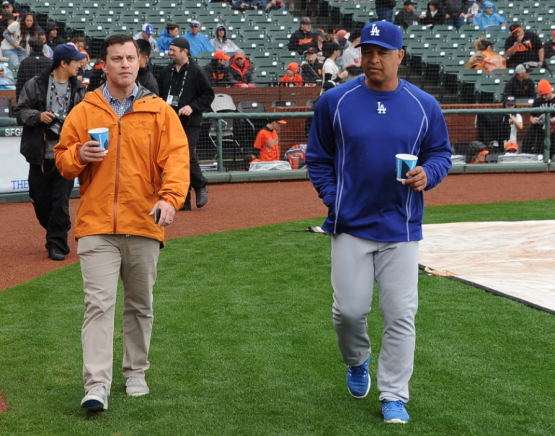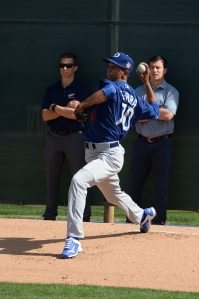
Andrew Friedman and Dave Roberts before a rain delay April 9 at San Francisco. (Jon SooHoo/Los Angeles Dodgers)
By Jon Weisman
Taking a break from the standing desk in his office overlooking left field at Dodger Stadium, 18 months into his tenure as Dodger president of baseball operations, Andrew Friedman was asked to reflect.
In the brief pause that followed, you could feel the sheer volume of all the moves and maneuvering roll through his brain like a freight train.
“It’s been such a frenetic pace,” Friedman said, “I feel like I’ve been drinking out of a firehose for the past year and a half.”
But the moment did provide an opportunity for Friedman to assess the state of the squad and look ahead toward a future filled with potential — all in pursuit of the unquestioned grand prize of a World Series title.
What follows are Friedman’s thoughts on three areas critical to that pursuit …
The bullpen
It’s unrealistic for a bullpen to be perfect, yet the expectation is dangerously close. Losing a lead is never not frustrating.
In the first three weeks of the season, Dodger relievers went to both ends of the extreme, surrendering three leads in their first 11 games, only to strike back with a 27 1/3-inning streak in which they allowed a single, inconsequential earned run before three came in at the end of Friday’s loss at Colorado.
“In some ways, relievers are like tightrope walkers,” Friedman said. “If you have the requisite stuff, so much of it is about confidence, and the preparation in terms of making sure that pitch selection isn’t the issue. Bardo (bullpen coach Josh Bard) has done a great job of starting to establish that culture in our bullpen of preparing ahead of time and putting themselves in the best position of really understanding what they want to do when they get out there.
“Like most things, it’s going to be better in June than it is today, but in our opinion, we have a lot of really talented guys down there,” Friedman continued. “I think the better your stuff, the more margin for error you have, but consistency is something that we’re very focused on.”
Always looking for an edge, the Dodgers have tinkered with what are now considered the traditional reliever roles (though what’s considered normal now would have been decidedly unconventional in decades past). At the big-league level, however, they’ve stopped short of deconstructing the system.
“I think that if we started fresh today, and no one had any experience of the last 20 years, we would probably design and deploy bullpens differently than we do today,” Friedman said. “That being said, it’s a very difficult thing to do with human emotions involved and the way that salary arbitration is set up and rewards guys for certain things, even though it might not necessarily correlate perfectly with what helps your team win the most games.
“It’s something that is slowly evolving, but I get why it’s slowly evolving. It’s a really tricky thing to navigate.”
Minor-league depth
Quickly, the Dodgers saw their organizational depth come into play in April, as they marched off to an early lead in the National League West despite having at least 10 players on the disabled list every day since the season began.
Going forward, what the Dodgers will do with that overflow of players is a tantalizing question.
“I think there’s certainly guys who are much more difficult for us to consider trading, (but) we have to keep an open mind and kind of vet each opportunity as it comes about,” Friedman said. “It certainly helps to have depth — it makes it much easier to make a consolidation trade, where you feel confident that even at the end of that, your farm system will still be pretty strong.”
For the prospects who remain in the organization, the challenge is how to welcome the future without undermining the present.
“The mindset that we have is to sustain success over a long period of time,” Friedman said, “and I think the only way that you do that is by integrating talented young players on to your roster in almost a slow-drip sort of way, as opposed to all at one time. I think it’s very difficult to have a lot of young players come up at the same time and be good in that year.
“If you’re able to integrate them over time, then they all get to gain experience. We’re not relying on them for team success, so that they can kind of go through those ups and downs and grow and mature, and by the time they get their feet under them and are ready to hit their stride, the next wave of a few young guys is being integrated onto the roster. I think it’s one of those things to ensure we don’t fall off the side of a cliff … so that as you look ahead two, three years, you feel like that the success you’re built to achieve in that current year, that you feel good about being able to sustain that over a long period of time.”

Only injuries have slowed Yasmani Grandal’s hot hitting with the Dodgers (Jon SooHoo/Los Angeles Dodgers)
Injury reduction
Though the Dodgers have devoted great resources toward keeping players healthy, their many injuries this spring put focus on whether a meaningful level of injury reduction is possible.
“It’s a fair question,” Friedman said. “I’m not positive I know the answer to it. We’re certainly going to seek out any advantage we can on that front. Even just a small effect on the margins has a dramatic impact on a roster and on a season, and it’s something we’ll continuously chase. And even if we make strides, there’s always going to be more we can do, so it’s kind of a never-ending goal of ours.”
The bigger the question — how to protect the arms of pitchers being one of the biggest — the slower the answer.
“It’s something we’re constantly talking about, thinking about, evaluating,” Friedman said. “The hard part is there’s not really immediate feedback, and it’s something you need a fairly lengthy period of time to kind of go through. And obviously, they’re all different. There’s arm injuries with pitchers, there’s soft-tissue injuries with position players. There’s just so many different things to isolate.”
Bonus topic: Kenta Maeda
For all the physical blows the Dodger starting rotation has taken, one unadulterated success through the first three weeks has been Kenta Maeda. His long-term, incentive-laden contract invited doubt from the media about his viability, but Maeda has already silenced many a skeptic.
“Specifically, I think the curveball is better than what we were expecting,” Friedman said. “His ability to pitch and change speeds is pretty much what we expected. We had a really good feel for what kind of athlete he is and also how well he handles the bat — obviously seeing him hit a home run in his first game really spoke to that.
Friedman said that the biggest potential pitfall for Maeda was how well he would adjust to life on this side of the Pacific.
“It gets to that specific player and how much they care about becoming a part of the fabric of the team,” Friedman said, “and from Day 1, Maeda has gone out of his way to be a great teammate. He is actively learning English, he’s got different inside jokes with different guys, and just how comfortable he feels contributes to his success on the mound.”







Phil Gurnee
Great read
Donna Goff
The first thing would be to use your best reliever when the game is most at risk. That might be in the 7th inning after a lead off double instead of protecting a 2 run lead in the 9th with batters 6-8 coming up.
frednaz
I would imagine there are pros and cons about using the best reliever in late inning critical situations versus saving that pitcher for the 9th inning save. There could be trouble brewing in one or all of the innings from 6th through the 8th and if the usual closer is used in one of those innings it would mean he would be up and warming up in each of those innings. A closer is more able to pitch one inning every night if he hasn’t warmed up and not pitched multiple times during a game without making an appearance.
Closing out a save in the ninth is similar to a starter knowing which game they will pitch.
Phil Gurnee
Would love to know how he would reconstruct a bullpen with out the historical constraints, egos, agents, financial issues that are involved. Hard to imagine any one doing any better then the World Champion Royals have done it, but they seem to be following the normal roles, just with excellent relievers.
Jon Weisman
Thanks, Phil. And it’s an interesting question.
Phil Gurnee
BTW, picked up the new daily program last week, I really like the new format. Big enough to read, small enough to put in the back pocket while walking around. Full of great info, and still has a scorecard to boot.
Jon Weisman
Appreciate that – thanks!
Craig Turner
There is some good information here Jon, thanks. But I wish Freidman would subject himself to more skeptical questioning from outside journalists, or even from fans. He tends to give interviews to his own employees, or the softball questioners from the MLB network. Bill Shaikin got some good, non-pr answers out of him, but that was the only instance I can recall where he took some tough questions. Frankly, it would improve his credibility.
Mark Tucker
Friedman wore an orange jacket to a game in San Francisco? The clubhouse kangaroo court probably doesn’t have jurisdiction over the front office, but he should have to pay for that faux pas!
Mark Hagerstrom
Ha!
Jayy Cali Cooper
fire the friedman matter ah fact the whole damn front office you guys stink